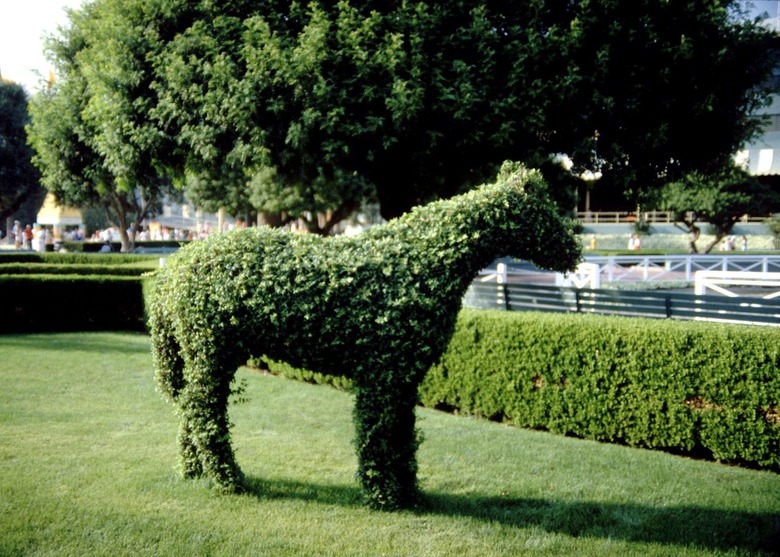Care Instructions For A Eugenia Topiary
Although it didn't get the name "topiary" until the Renaissance, the art of cutting shrubs and trees into shapes goes back as far as the ancient Greeks, Romans and Egyptians. Eugenia myrtifolia, or Australian brush cherry, is a popular topiary plant, with its dark green foliage, its wispy flowers and its bright red, non-edible cherries. When you add Eugenia topiary to your garden, you join the Italian artists of the Middle Ages and the cottage gardeners of the Victorian era in enjoying living sculptures.
Containers and Placement
Step 1
Your brush cherry topiary will grow in nearly any type of planter, but unglazed clay pots allow moisture to evaporate from the soil more quickly than glazed terra cotta or plastic containers, so the plants may dry out more, as well. Once you've chosen a container and planted your shrub, place it so that it has plenty of elbow room, making sure it doesn't touch nearby plants, walls or other objects.
Temperatures and Light
Step 1
Eugenia will thrive in U.S. Department of Agriculture hardiness zones 9 to 11, although you should cover them or otherwise provide warm shelter if the air temperatures will drop to 32 Fahrenheit degrees or lower. Your plant will be happiest with four or more hours of morning and late-day, full to partial sunlight.
- Although it didn't get the name "topiary" until the Renaissance, the art of cutting shrubs and trees into shapes goes back as far as the ancient Greeks, Romans and Egyptians.
- Your brush cherry topiary will grow in nearly any type of planter, but unglazed clay pots allow moisture to evaporate from the soil more quickly than glazed terra cotta or plastic containers, so the plants may dry out more, as well.
Water and Food
Step 1
Your topiary needs consistent moisture, but it doesn't like wet feet from standing water. Eugenia is also sensitive to salts in the water, so give your plant distilled or reverse osmosis water drinks every day during the warmer months, then water it two or three times a week when the weather cools. To eliminate air pockets around the roots that might interfere with water absorption, lower the pot into a larger vessel filled with water to saturate the soil completely. After that, water your topiary when the soil dries to a depth of about 1/2 inch. Feed your plant every two to three months with a general-purpose 13-13-13 fertilizer, using the amounts recommended on the label for the size of container you are using.
Pruning
Step 1
Even though Eugenia is a slow-growing plant, topiaries need frequent pruning to maintain their whimsical shapes. Using hand pruners or sharp gardening scissors, cut the lighter green new growth from your plant every few weeks. If you are starting with a new shrub, you can trim it into cones, balls, tiered poofs or any other shape you can imagine, although it might take a few years to see more complicated designs reach their full effect because of the plant's slow growth habits. Remember that visitors may see your topiary from all sides, so be sure you walk around it as you prune, checking for balance and shape all around. You can cut Eugenia back dramatically, so don't worry if you miss a scheduled clipping. Always sterilize your shears before and between cuttings to prevent the spread of disease.
- Your topiary needs consistent moisture, but it doesn't like wet feet from standing water.
- Remember that visitors may see your topiary from all sides, so be sure you walk around it as you prune, checking for balance and shape all around.
